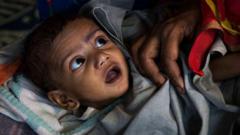The missing puzzle piece in India’s child stunting crisis emerges with stunning statistics showing that 35% of the nation’s 137 million children under five years old are stunted, a troubling reflection of malnutrition. A two-region analysis reveals that together, India and Sub-Saharan Africa encompass 44% of the global under-five population, but account for around 70% of the world's stunted children. Despite improvements in both areas, India’s stunting rate stands at 35.7%, surpassing the average of 33.6% in Sub-Saharan Africa, which consists of 49 countries.
A child is classified as stunted when their height fails to meet age expectations, indicating significant nutritional deficiencies. However, research conducted by Ashwini Deshpande from Ashoka University and Rajesh Ramachandran from Monash University sheds light on the often-overlooked significance of caste as a determining factor in malnutrition in India, rather than just the physical height discrepancies when compared to African children.
The first 1,000 days, termed the "golden period," are pivotal as they set the groundwork for a child's lifelong potential due to rapid brain development occurring in early life. Essential components during these years include healthcare, nutrition, early learning, and a nurturing environment. Data from the World Bank underlines that Sub-Saharan Africa and South Asia, particularly India, represent over 85% of the global poor, suggesting similar struggles against poverty.
Exploring the statistics, the researchers observed that children from marginalized groups, including adivasis and Dalits, constitute more than a third of India’s under-five demographic. Surprisingly, children hailing from higher-ranked, non-stigmatized castes face a stunting rate of only 27%, substantially lower than their Sub-Saharan African counterparts. The findings demonstrate that children stemming from privileged caste backgrounds experience a 20% lower likelihood of stunting compared to those in disadvantaged groups, highlighting the long-standing impact of India’s entrenched caste system despite generations of affirmative action.
The complex discourse surrounding high stunting rates among Indian children has spurred various theories, with some attributing these disparities to genetic factors, while others argue for improved generational nutrition leading to gradual size increases. Notably, some studies indicate gender-based discrepancies in stunting rates, depending on differing global criteria.
Despite a noticeable decline in stunting across social factions, recent studies indicate that children from poorer families, those with less-educated mothers, and marginalized groups face heightened vulnerability. The discourse surrounding the height disparities between Indian and Sub-Saharan African children tends to disregard the pressing role of caste identity, which is vital for understanding the nutritional challenges faced by children in India.
Using comprehensive demographic and health survey data, this analysis compares the nutritional outcomes of 195,024 Indian children to 202,557 under-five children in Sub-Saharan Africa. The results reflect the deep-rooted social dynamics affecting child nutrition and highlight the need for targeted interventions within the context of India's caste-based disparities.
A child is classified as stunted when their height fails to meet age expectations, indicating significant nutritional deficiencies. However, research conducted by Ashwini Deshpande from Ashoka University and Rajesh Ramachandran from Monash University sheds light on the often-overlooked significance of caste as a determining factor in malnutrition in India, rather than just the physical height discrepancies when compared to African children.
The first 1,000 days, termed the "golden period," are pivotal as they set the groundwork for a child's lifelong potential due to rapid brain development occurring in early life. Essential components during these years include healthcare, nutrition, early learning, and a nurturing environment. Data from the World Bank underlines that Sub-Saharan Africa and South Asia, particularly India, represent over 85% of the global poor, suggesting similar struggles against poverty.
Exploring the statistics, the researchers observed that children from marginalized groups, including adivasis and Dalits, constitute more than a third of India’s under-five demographic. Surprisingly, children hailing from higher-ranked, non-stigmatized castes face a stunting rate of only 27%, substantially lower than their Sub-Saharan African counterparts. The findings demonstrate that children stemming from privileged caste backgrounds experience a 20% lower likelihood of stunting compared to those in disadvantaged groups, highlighting the long-standing impact of India’s entrenched caste system despite generations of affirmative action.
The complex discourse surrounding high stunting rates among Indian children has spurred various theories, with some attributing these disparities to genetic factors, while others argue for improved generational nutrition leading to gradual size increases. Notably, some studies indicate gender-based discrepancies in stunting rates, depending on differing global criteria.
Despite a noticeable decline in stunting across social factions, recent studies indicate that children from poorer families, those with less-educated mothers, and marginalized groups face heightened vulnerability. The discourse surrounding the height disparities between Indian and Sub-Saharan African children tends to disregard the pressing role of caste identity, which is vital for understanding the nutritional challenges faced by children in India.
Using comprehensive demographic and health survey data, this analysis compares the nutritional outcomes of 195,024 Indian children to 202,557 under-five children in Sub-Saharan Africa. The results reflect the deep-rooted social dynamics affecting child nutrition and highlight the need for targeted interventions within the context of India's caste-based disparities.




















